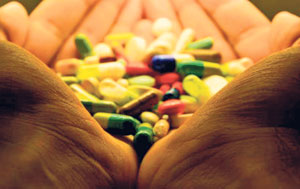Illnesses and medicines have been part of our lives from time immemorial.
Usually, when someone is ill, he will see a doctor who will examine him, diagnose the problem and write out a prescription, explaining how the medicines should be taken.
But many are the issues we face when taking medicines or administering them to others especially a child or an elderly person. Ranging from simple to complex, there is no way we can find answers to those concerns and worries, even after reading those leaflets with tiny lettering which come with medicines.
 |
| Dr. Chamari Lochana Weeraratne |
In this series we launch today, MediScene will reveal all to you about this essential aspect, with the expertise of Specialist Physician Dr. Chamari Lochana Weeraratne who is a Senior Lecturer at the Department of Pharmacology, Faculty of Medicine, University of Colombo.
Dr. Weeraratne has already put out a book titled ‘Oushada Bavithayata Athwelak’ (A helping hand in the use of medicines) in Sinhala and hopes to get in print this series in MediScene for the English readership.
“Medicines are not only used to treat acute illnesses such as flu, pneumonia and acute bronchitis but also to prevent and treat diseases such as myocardial infarction (heart attack) or stroke (brain attack),” stresses Dr. Weeraratne, explaining that some people need to take medicines all their life for long-term ailments such as asthma, diabetes, hypertension (high blood pressure), epilepsy etc.
That is why everyone should be armed with the necessary knowledge and skills when taking or giving medicines.
“Even the best of medicines would be of little use if this knowledge and skill are absent,” says Dr. Weeraratne who wishes to fill that lacuna between doctor and patient, pointing out that irrational use may in fact harm you. Many suffer adverse effects due to this.
This series will have:
- General knowledge for anyone using medicines
- Administration of different types of medicines including eye and ear drops, nasal sprays, inhalers etc.
- Administering medicines in special situations – to a child, an elderly person, a pregnant or breastfeeding (lactating) mother and a patient with a disability, especially visual impairment.
- Special notes on antibiotic use, how to use the asthma inhaler or administer the insulin injection
- Maintenance of medical records
General knowledge
What is a drug? A drug is a substance that changes a biological system by interacting with it. Such a substance or drug may be used to bring down an abnormally high heart rate to a normal level, to normalize the blood pressure in a patient with hypertension, to normalize blood glucose levels in a diabetic or to control infection and inflammation.
A drug is identified by three names:
Chemical name – this is based on its chemical composition and could be a tongue-twister due to its complexity.
Generic or International Non-proprietary Name (INN) – this is the official name of the drug, which although usually derived from its chemical name, is simpler. The generic name helps to identify a particular drug the world-over, except for a few exceptions. Amoxicillin is known as amoxicillin whether it is Sri Lanka, Australia, England or America.
 |
| Courtesy Getty images |
The very few exceptions include paracetamol which may also be known as acetaminophen in some countries.
Brand, trade or proprietary name – this is the name given by the company that manufactures a particular drug. Therefore, this name will vary from one company to the other.
The trade name given to the drug by the first or pioneer company which produces the drug is called the “innovator brand”.
What are the similarities between generics and brands?
- The ‘active’ ingredient is the same in both generics and brands.
- The quantity of the active ingredient is more or less the same in both.
- There is similar efficacy (how effective it is) in both the generic and the brand.
What are the differences between generics and brands?
- The appearance such as size, shape and colour may be different.
- The drug could take a different form – capsules, tablets, syrups etc.
- The ‘inactive’ ingredients in the drug preparation could change in the generic or brand, with the inclusion of salt, sugar, alcohol and colouring and flavouring agents. This will be an important consideration at times as a sugar-coated drug will not be suitable for a diabetic; alcohol-based preparations will not be good for infants and children; and those with sodium chloride (salt) should not be taken by people suffering from hypertension.
The different forms of
medications are:
Tablets, capsules, syrups, injections, suppositories (inserted to the anus), pessaries (inserted to the vagina) and skin creams and ointments.
(To be continued next month) |



